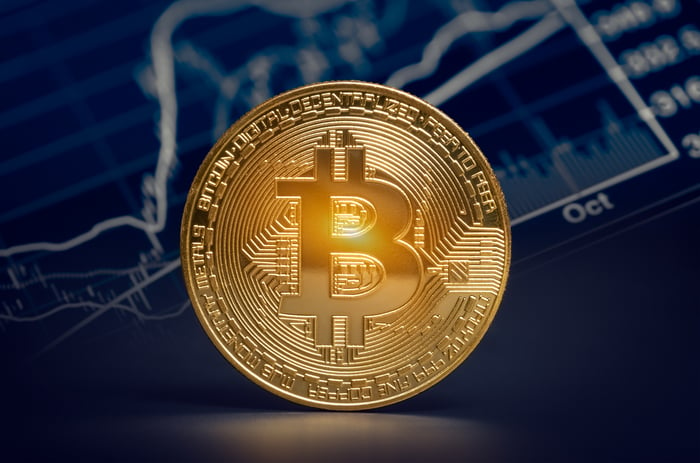Cathie Wood is the head of Ark Investment Management, which operates 14 exchange-traded funds (ETFs) focused on technological innovations. They include everything from artificial intelligence (AI) to electric vehicles to cryptocurrency.
Ark is extremely bullish on the world’s largest cryptocurrency, Bitcoin (BTC -1.77%). The firm’s official research implies the coin could deliver a gain of 2,000% by 2030, but Wood herself just came out with a new price target that points to a potential upside of more than 5,300%.
Bitcoin is trading near an all-time high right now and investors are as enthusiastic about its prospects as ever, but is Wood’s forecast realistic?

Image source: Getty Images.
Bitcoin is a unique asset
Bitcoin is often discussed as a replacement for traditional money. It isn’t governed by any person or institution, and the blockchain upon which it is built is an accurate and transparent system of record. But its price is incredibly volatile; Bitcoin lost 65% of its value in 2022 and it has since gained about 325% from its low point that year. As a result, it’s too unpredictable to become a means of exchange for most consumers and businesses.
Many investors instead consider Bitcoin a store of value — like a digital version of gold — and it has outperformed every other major asset class during the past five years:
Bitcoin Price data by YCharts
The investment thesis behind Bitcoin is relatively simple. Supply is limited to 21 million coins, which are paid to miners who use powerful computers to add new blocks to the blockchain. A halving is triggered with every 210,000 new blocks, which cuts the reward for mining Bitcoin in half. Estimates suggest the last Bitcoin will be mined sometime around the year 2140.
Since supply is capped, demand alone drives the price. There are nearly 50 million wallets which hold entire bitcoins or partial coins. That figure is near an all-time high. Plus, 2023 was one of the most active years for wallet creation, which is a good indicator of demand. Theoretically, Bitcoin’s limited supply will ensure prices move higher for as long as people continue opening new wallets to buy the cryptocurrency.
However, that alone might not be enough for Bitcoin to deliver the astronomical gains touted by Ark and Wood.
Ark’s catalysts for a higher Bitcoin price
Ark highlights eight potential sources of demand for Bitcoin that could send its price soaring by 2030:
- Corporate treasury: Ark believes companies will eventually hold between 0% (bear case) and 5% (bull case) of their cash reserves in Bitcoin.
- Remittance asset: Bitcoin could represent between 5% and 25% of all non-commercial money transfers.
- Nation state treasury: Government treasury departments around the world could hold between 0% and 5% of their assets in Bitcoin.
- Emerging market currency: Bitcoin could be the primary currency in some developing nations. El Salvador already adopted it as legal tender.
- Economic settlement network: Bitcoin could eliminate a number of fees imposed by banks and financial institutions, capturing between 1% and 10% of U.S. bank settlement volume.
- Seizure-resistant asset: Between 1% and 5% of the global wealth held by high net worth individuals could be stored in Bitcoin to protect it from the government.
- Institutional investment: Banks and financial institutions could place between 1% and 6.5% of their assets in Bitcoin because they believe it will further appreciate in value.
- Digital gold: Between 20% and 50% of the money investors normally allocate to gold could eventually be placed in Bitcoin instead, thanks to its strong performance and portability.
Here’s how high Ark believes Bitcoin can rise by 2030 based on the demand generated by those eight catalysts:
- Bear case: $258,500, representing an upside of about 270% from today’s price of roughly $69,000.
- Base case: $682,800, representing an upside of 880%.
- Bull case: $1,480,000, representing an upside of 2,400%.
But Cathie Wood just doubled down
Wood spoke at the Bitcoin Investor Day conference in New York last week, where she said Bitcoin could actually eclipse Ark’s 2030 price target of $1.48 million and instead soar to $3.8 million. The 5,300% upside could be driven by further adoption of Bitcoin exchange-traded funds (ETFs), which won the approval of the U.S. Securities and Exchange Commission (SEC) in January.
So far, the 10 approved ETF operators — including Ark — manage more than $58 billion worth of assets in their Bitcoin funds, and that figure is growing. Wood says if institutional investors allocated a little more than 5% of their portfolios to Bitcoin, that alone would be enough to warrant a price of $3.8 million.
Wood thinks Bitcoin still has miles to go in terms of upside. She believes the cryptocurrency is key to an internet-based means of transacting that eliminates toll takers like banks and financial institutions, which collect a fee almost every time money moves.
Is Wood’s forecast realistic?
Past performance doesn’t predict future results, so there is no guarantee Bitcoin will continue to outperform other asset classes, let alone surge more than 50-fold.
The cryptocurrency would have a market capitalization of $74.7 trillion if it did reach a price of $3.8 million, making it nearly three times more valuable than the U.S. economy by gross domestic product, and 23 times more valuable than the largest company in the world (Microsoft).
To me, that seems unlikely. Treating Bitcoin as a store of value does make sense, and perhaps one day it could have a similar market cap to gold, which currently stands at $14.6 trillion. That would translate to a 10-fold return in Bitcoin from here, taking it to $743,500, which is slightly above Ark‘s base-case estimate.
Anthony Di Pizio has no position in any of the stocks mentioned. The Motley Fool has positions in and recommends Bitcoin and Microsoft. The Motley Fool recommends the following options: long January 2026 $395 calls on Microsoft and short January 2026 $405 calls on Microsoft. The Motley Fool has a disclosure policy.





